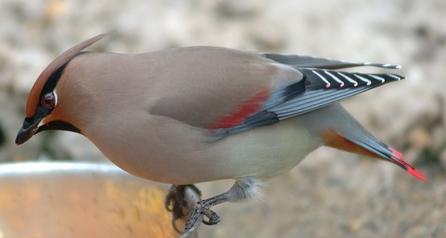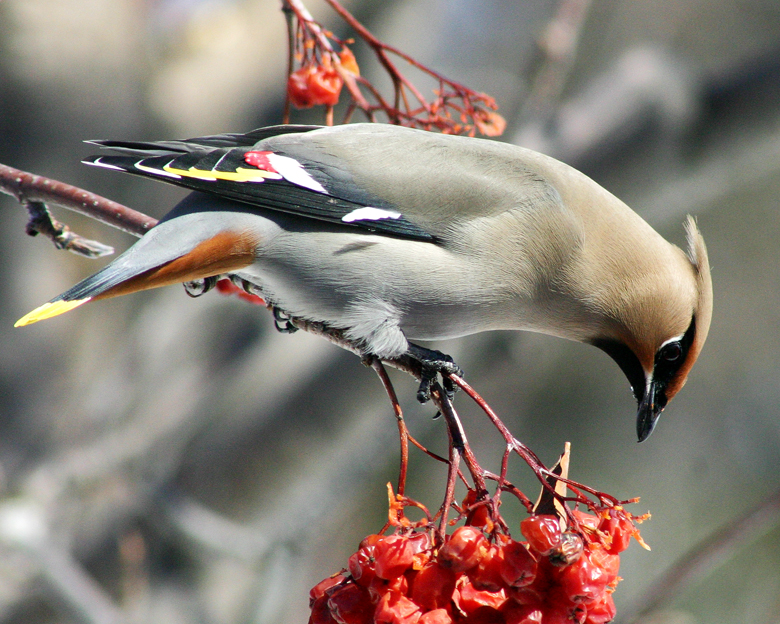I saw a few Cedar Waxwings the other day, such elegant and poised birds. In their small genus Bombycilla are two other waxwing species: the Bohemian and Japanese Waxwings. Similar in size and shape, all waxwings possess a tapering crest, a black stripe through the eye extending over the beak, usually waxy-appearing tips on the secondary wing feathers, and a squared-off yellow-tipped tail. (Some Cedar Waxwings have orange tail tips, a result of eating the berries of an introduced honeysuckle.) Their plumage is pinkish-brown and distinctively smooth. The Cedar Waxwing summers and breeds in southern Canada, permanently resides in the north central U.S. and winters southward to Central America. Six to eight inches long, the sexes are similar. The larger Bohemian Waxwing breeds in the far north of Canada through Alaska, some populations permanently residing in southern Canada and the northern U.S., and they winter in the northern U.S. The Japanese waxwing, lacking the red tips on the wing feathers, breeds in coniferous forests in the Russian Far East and north-east China, wintering in Japan, Korea and eastern China. Collectively waxwings have we call a Holarctic distribution.

Bombycilla derives from the Latin and has been interpreted a few ways, but “silky” seems to be the best answer. The waxwing name comes from the fused red tips of the secondary feathers which appear to have been dipped in sealing wax. The common name cedar comes from their plumage color, Bohemian from their wandering tendency, and Japanese from their wintering location.


Waxwings are fruit eaters, taking mulberries, serviceberries, pyracantha and mistletoe berries, rose hips, crabapples, and the like. They sometimes go on a binge and gorge themselves with berries; their digestive system can digest the fleshy part of a berry and defecate the skin and pit in 16 minutes. Often feeding in flocks in the winter, individual birds have been seen passing a berry to its neighbor, presumably because the passer is full at the moment. Occasionally waxwings will stuff themselves with fermented berries and get inebriated. During the breeding season the birds will eat insects for additional protein.
Adult Cedar Waxwings are monogamous during the breeding season. The male courts the female by dancing and offering her fruit or insects. The gift may be passed back and forth until the female eventually eats it. The pair typically produces one to two clutches from June to August.
The waxy tips on the wings vary in number and are related to the age of the bird. Second year birds have no waxy tips at all but as the birds age, the number of waxy tips increases in both male and female. Cedar Waxwings mate assortatively with respect to the number of tips on the secondaries of the birds. Pairs of older birds (with more tips) tended to nest earlier than younger (fewer tips) birds. Older birds also had larger clutch/brood sizes and fledged more young. It appears that the waxlike tips function as age and status symbols and that competition for mates results in assortative mating.